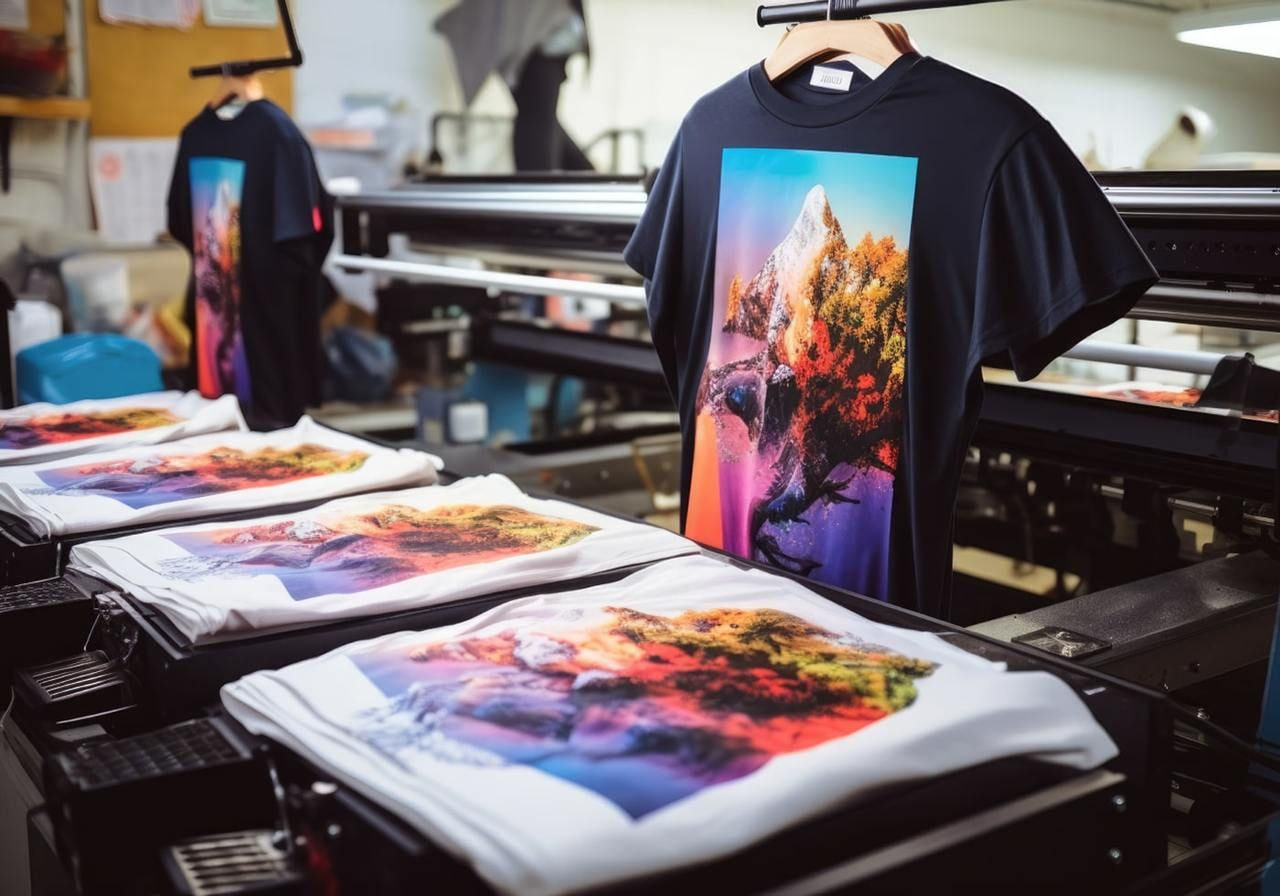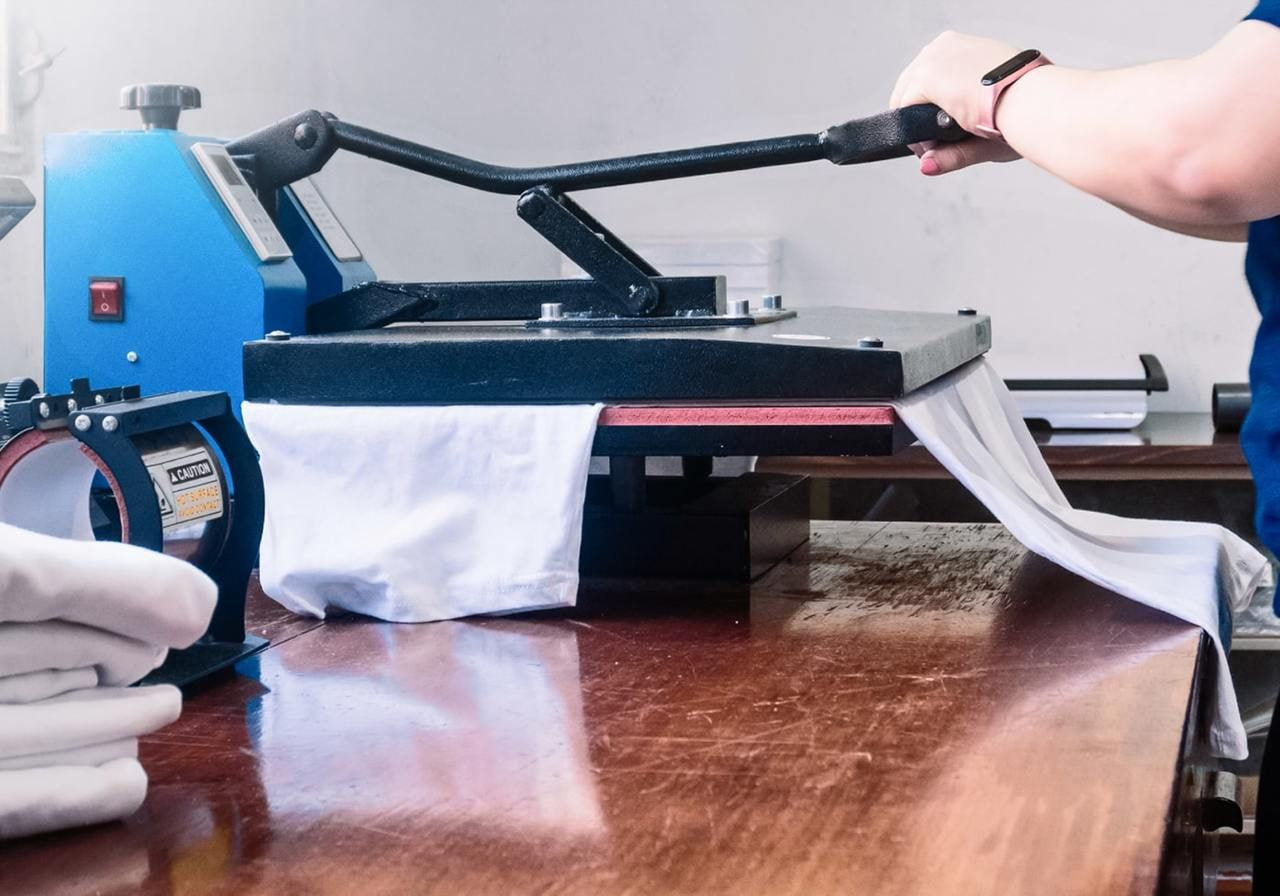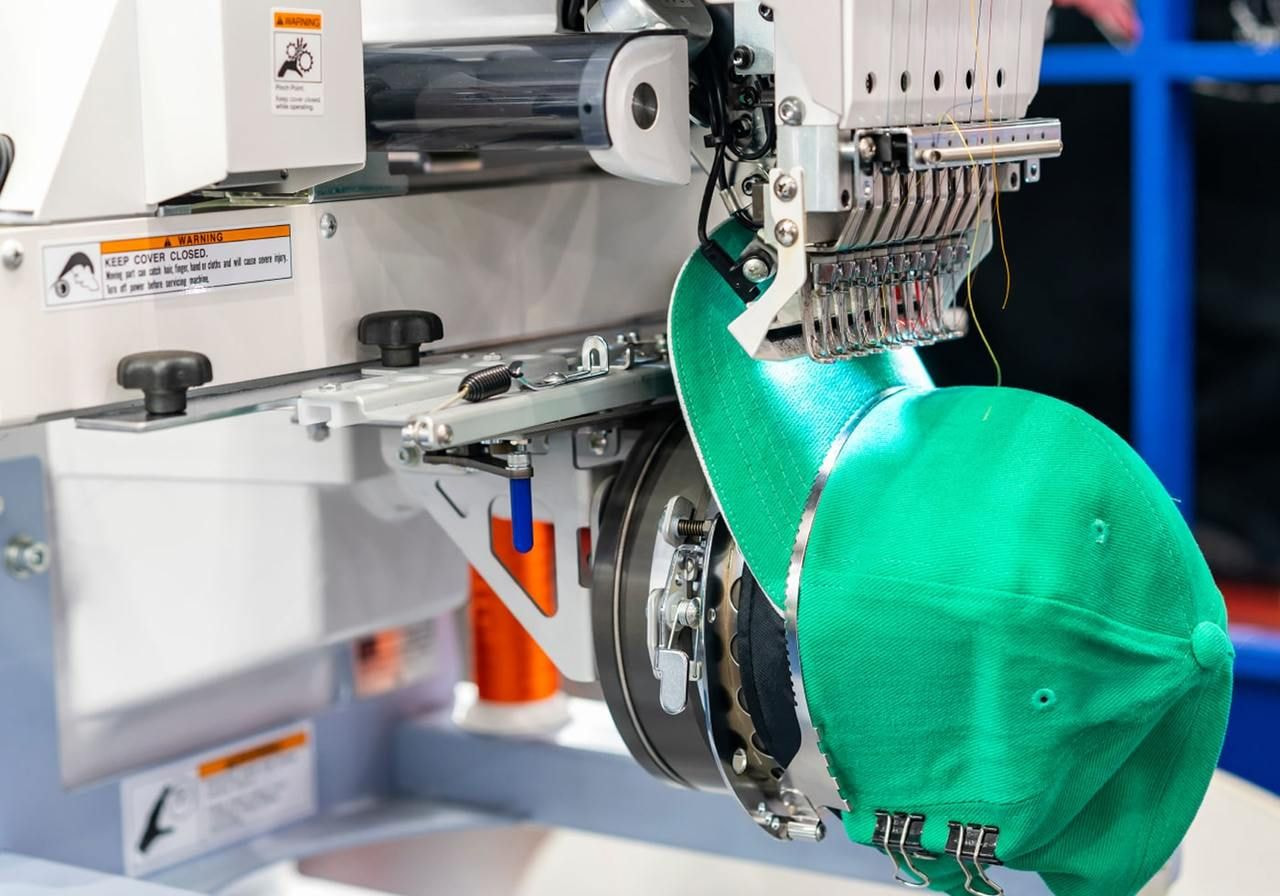Table of contents
When you’re scaling merch for a concert, outfitting a sports team, or stocking shelves for retail, the printing method you choose can make or break your margins. Bulk orders aren’t quick fixes – they’re about balancing cost, speed, and print quality at scale.
In this guide, we’ll unpack the leading custom printing methods, from tried-and-true screen printing to digital techniques, so you know which method fits your high-volume production goals.
Top bulk printing methods at a glance
|
Printing method |
Best for |
Fabric compatibility |
Design complexity |
Durability |
Hand-feel |
Cost-effectiveness at scale |
Typical use cases |
|
Screen printing |
Large runs with few solid colors |
Best on cotton and blends |
Limited (flat, bold designs) |
Very high – wash-resistant |
Slightly raised texture |
Excellent for 100+ items |
Band merch, promo tees, uniforms, wholesale stock |
|
DTG (direct to garment) |
Detailed, colorful custom designs |
Works best on cotton |
High (photos, gradients) |
Moderate to high |
Soft, smooth finish |
Moderate for small/medium |
Boutique brands, drops |
|
Sublimation printing |
All-over prints, patterns |
Polyester and synthetics |
High (full-color, seamless) |
Extremely high |
No added texture |
Cost-effective for polyester |
Sports jerseys, event gear, mugs, phone cases |
|
Heat transfer/vinyl |
Personalization, small to mid runs |
Cotton, polyester, blends |
Moderate to high (varies by type) |
Good, but can peel/crack |
Raised, plasticky feel |
Less cost-effective at scale |
Names/numbers on jerseys, promo tees, custom items |
|
Embroidery |
Premium branding, corporate merch |
Works best on thicker fabrics |
Limited (simple logos, text) |
Highest – thread won’t fade |
Textured, stitched feel |
High cost per unit |
Polos, caps, jackets, high-end apparel |


Key factors to consider before choosing a bulk printing method

Cost per unit
The cost per unit is the amount you’ll pay for each item when producing in bulk. It includes setup fees, ink usage, and labor, averaged across the total order.
Some printing methods – like screen printing – have high setup costs but become more cost-effective at scale. Other printing methods, like DTG printing, have no setup costs but maintain a steady price per item regardless of quantity.
Understanding cost per unit helps businesses plan for campaigns, retail margins, and event budgets, especially when balancing volume against profitability.
-
Screen printing: high setup, but very practical at scale
-
DTG: no setup costs, better for small to mid runs
-
Sublimation: efficient when producing many polyester items
-
Heat transfer: lower entry cost, not ideal for high volumes
-
Embroidery: higher per-unit cost, premium value
Design complexity
Design complexity covers the number of colors, level of detail, and effects like gradients or photographs in your artwork.
Some t-shirt printing methods – like screen printing – handle solid logos and bold shapes with ease. Meanwhile, others, such as DTG printing, excel at intricate or photo-realistic images.
The more complex the design, the more you need methods to handle fine detail without losing clarity. Choosing based on complexity ensures your custom t-shirt printing aligns with the brand identity you’re aiming for.
-
Screen printing: great for bold, simple designs like logos, solid shapes, or line art
-
DTG: handles complex details and full-color prints, including photos, gradients, and multi-color art
-
Sublimation: best for seamless all-over artwork
-
Heat transfer: flexible for moderate complexity, such as multi-layer logos
-
Embroidery: limited to simple logos, text, and lining
Material and product variety
The fabric and product type directly affect which shirt printing methods will work best. Cotton, polyester, and blends react differently to inks and t-shirt printing process choices.
Some methods are fabric-specific – like dye sublimation, which bonds only with synthetics. Screen printing, DTG, and heat transfer printing are more versatile across cotton and blended materials. Embroidery, on the other hand, works best on thicker garments like jackets and caps.
Considering material ensures your design looks and feels how you expect, whether you’re making custom shirts, jerseys, mugs, or hats.
-
Screen printing: best on cotton and blends
-
DTG: works well on natural fabrics and cotton blends
-
Sublimation: only works on polyester or synthetics
-
Heat transfer: adaptable across fabrics and hard products (like mugs)
-
Embroidery: ideal for thicker garments and caps
Turnaround time and logistics
Turnaround time measures how quickly a bulk order can be completed, including setup, production, and delivery. Some printing methods are fast once prepared, while others slow down at high volumes.
Logistics matter too – like shipping deadlines, event schedules, or retail launches. Choosing based on time avoids delays, increasing customer satisfaction with your t-shirts and other products.
-
Screen printing: slower setup, but quick once running
-
DTG: steady pace, better for smaller orders
-
Sublimation: reliable speed for mid-size runs
-
Heat transfer: fast for small batches, slower at scale
-
Embroidery: longer turnaround for big volumes
Durability
Durability refers to how long prints maintain color, detail, and quality through washing and daily wear. Some t-shirt printing methods produce durable prints that last for years, while others may fade or crack more quickly.
For uniforms, sports gear, or promotional t-shirts, durability determines whether a method is worth the investment. Picking the right approach keeps your brand looking fresh long after the first wear.
-
Screen printing: highly durable and long-lasting
-
DTG: good lifespan, but can fade with time
-
Sublimation: permanent, won’t crack or peel
-
Heat transfer: holds up but may peel eventually
-
Embroidery: highly durable, outlasts most fabrics themselves
Feel and finish
Feel and finish are the tactile result of the printing – whether the design sits on top of the fabric, blends into it, or adds texture. This factor affects comfort and perception, especially for retail-ready apparel.
A soft, breathable t-shirt feels very different than one with a plasticky surface. Considering this helps align the final product with your brand’s desired look and customer experience.
-
Screen printing: slightly raised, textured feel
-
DTG: soft and smooth to the touch, blends into the fabric
-
Sublimation: no extra texture, breathable
-
Heat transfer: plasticky or smooth finish, depending on vinyl type
-
Embroidery: stitched, textured surface
Minimum order quantity
Minimum order quantity (MOQ) is the smallest number of items you need for a printing method to be cost-effective. Some t-shirt printing methods work well for one-off or small runs, while others only pay off once you order 50, 100, or more.
Knowing the MOQ helps businesses balance flexibility with price and avoid overspending on the wrong shirt printing approach.
-
Screen printing: efficient for 50-100 or more units
-
DTG: no minimums, ideal for 1-50 and more items
-
Sublimation: better for medium to large polyester runs
-
Heat transfer: great for small, personalized orders
-
Embroidery: no MOQ, but costs rise per piece
Pro tip: Partner with Printful and forget about minimums! We handle orders of any size for embroidery, DTG, and other printing techniques.
Eco-friendliness
Eco-friendliness covers the environmental impact of different printing methods, from ink type to waste levels. Brands today consider whether inks are water-based, if production minimizes leftovers, and how long the design lasts before replacement is needed.
Sustainable printing options help your business appeal to eco-conscious buyers and reduce waste, making them increasingly important when choosing a shirt printing approach.
-
Screen printing: more sustainable with water-based inks
-
DTG: on-demand, prevents excess stock
-
Sublimation: long-lasting, minimal waste
-
Heat transfer: vinyl may be less eco-friendly
-
Embroidery: low waste, depends on thread sourcing


5 Leading printing methods for bulk orders

Bulk screen printing
Screen printing is the most established printing method for bulk t-shirt production. The screen printing process involves creating stencils (screens) for each color and pressing water-based inks or plastisol through the mesh directly onto fabric. This makes it ideal for custom t-shirts with bold, simple graphics.
Best for: Large runs of custom apparel like t-shirt lines, uniforms, promotional wear, and custom merchandise, where designs use limited colors.
Result and durability: Prints come out bold with vibrant colors, sharp edges, and a slightly raised texture. It’s one of the best high-volume printing solutions, lasting through dozens of washes with minimal fading.
Pros
-
Extremely cost-effective at scale (perfect for bulk t-shirt printing)
-
Long-lasting, sturdy prints
-
Excellent for bold logos and solid color designs
Cons
-
Slow and expensive initial setup
-
Not suited for complex designs or gradients
-
Limited flexibility for short runs
Feel and products: The design sits on top of the fabric with a noticeable texture. Traditional screen printing works best on cotton and cotton blends, making it the go-to option for wholesale custom t-shirts.
DTG (direct-to-garment) printing
DTG printing is a modern technique that uses a specialized DTG printer to print directly onto fabric. Unlike traditional screen printing, direct-to-garment supports unlimited color combinations and fine detail.
Best for: Custom t-shirt printing with detailed artwork, gradients, and colorful designs. Meant for brands that want sample print runs or bulk DTG printing with multiple design variations.
Result and durability: DTG produces soft-to-touch, high-quality prints with excellent detail. They’re washable and reliable, though less durable than the screen printing method.
Pros
-
Excellent for complex designs and photo-quality graphics
-
Ideal for short to medium runs with many variations
-
No setup screens required
Cons
-
Slower than screen printing for huge runs
-
Limited to cotton and other natural fabrics
-
Higher per-unit cost for thousands of t-shirts
Feel and products: Because the inks soak into the fibers, DTG feels smooth and lightweight. It shines on 100% cotton t-shirts – ideal for branded apparel lines needing intricate designs and different printing methods across collections.
Sublimation printing
Sublimation printing (a.k.a. dye sublimation) uses sublimation ink and special transfer paper to embed designs into polyester fibers. Heat and pressure turn the ink into gas, bonding it directly with synthetic fabrics.
Best for: All-over designs on polyester t-shirts, sports jerseys, performance wear, and promotional items like mugs or phone cases.
Result and durability: Produces permanent, vibrant colors that never crack or peel. Designs become part of the fabric, creating lightweight, breathable, and durable prints.
Pros
-
Seamless all-over printing
-
Extremely long-lasting with no added texture
-
Perfect for colorful designs and photographic detail
Cons
-
Limited to synthetic fabrics (polyester)
-
Not effective on cotton or dark garments
-
Requires light fabrics for good results
Feel and products: Because the print fuses with the material, there’s no extra layer – you only feel the shirt. A popular shirt printing technique for sports uniforms, event gear, and creating personalized items at scale.
Heat transfer and vinyl printing
Heat transfer printing uses a heat press to apply designs from special transfer paper or vinyl sheets onto fabric. Vinyl printing specifically uses cut vinyl pieces that adhere under heat and pressure.
Best for: Small to medium runs of custom t-shirts, names and numbers on jerseys, limited-edition custom designs, and personalization.
Result and durability: Heat transfer vinyl printing produces bold, opaque designs on top of the fabric with a smooth or textured finish. Considered a durable printing method, though heavy washing may cause peeling or cracking over time.
Pros
-
Excellent for short runs and creating personalized items
-
Works on cotton, polyester, and blended fabrics
-
Handles multi-color and photographic prints
Cons
-
Less profitable for high-volume orders
-
Thicker feel than digital printing or DTG
-
May peel or crack with frequent washing
Feel and products: These t-shirt printing methods leave a slightly raised, plasticky finish, depending on the vinyl. Perfect for sports gear, promotional tees, and custom apparel for businesses needing name or logo variations.
Embroidery

Embroidery for bulk orders is a timeless decoration method where threads are stitched directly into fabric using automated machines. Unlike other t-shirt printing techniques, it creates a textured, premium look.
Best for: Polo shirts, caps, jackets, and custom apparel where durability and brand elevation matter more than fine detail.
Result and durability: Designs are physically stitched into the garment, creating highly lasting prints, making embroidery one of the most durable printing methods.
Pros
-
Long-lasting, professional appearance
-
Adds premium value to branded apparel
-
Works well on thicker materials and structured garments
Cons
-
Higher cost than other custom t-shirt printing methods
-
Not suitable for detailed or colorful artwork with gradients
-
Less ideal for lightweight t-shirts
Feel and products: Embroidery adds texture and dimension. Best for polos, hats, hoodies, jackets, and high-end custom apparel businesses. While not the best printing method for bulk orders, it’s unbeatable for upscale custom merchandise.
Conclusion
There’s no single best printing method for bulk orders. Each of the leading shirt printing methods – from dye sublimation to heat transfer printing to custom embroidery – has wins depending on design, material, cost, and volume.
By comparing factors like durability, turnaround, and feel, businesses can identify the right solution to match their goals, budgets, and timelines while ensuring their prints meet expectations at scale. Partnering with Printful makes it easier, with access to multiple shirt printing methods, bulk discounts, and fulfillment support for orders of any size.


FAQs:
Screen printing is the most common way to print t-shirts at scale. Once screens are created, the setup cost spreads across the order, making each piece more affordable. This technique delivers durable, vibrant designs, making it one of the best printing methods for large orders.
Offset printing (lithography) remains the industry standard for high-volume paper printing thanks to its speed and cost efficiency. That said, digital printing is quickly gaining popularity for its speed, flexibility, and ease of handling small, personalized runs.

By Baiba Blain
With 7+ years of experience in translation and creative writing, Baiba now leads a squad of talented writers, balancing research-backed storytelling with team guidance, quality assurance, and SEO processes. Outside of work, she enjoys exploring old castles, spontaneous road trips, and talking back to her cats. 10/10 arguments won so far.





